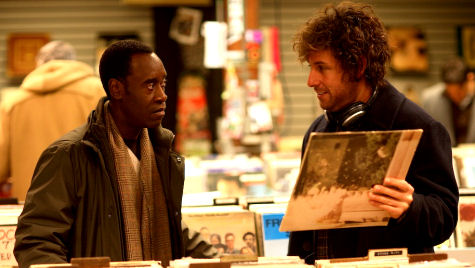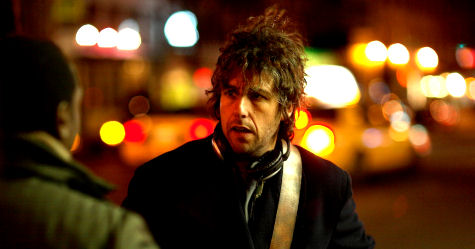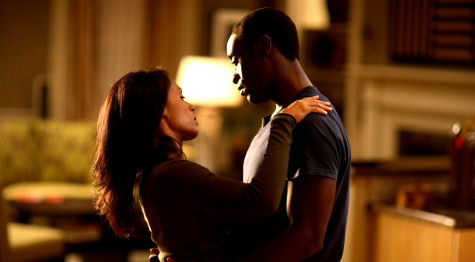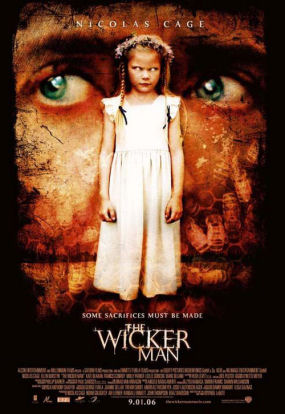“No other writer-producer-director makes males more excited at the prospect of a new film — especially a cop thriller — than Michael Mann. But it’s an anticipation that crosses gender and taste barriers, integrating art film buffs with the Friday night popcorn crowd. Fans look to this peerless creator of impeccably crafted films about existential male loners — films such as The Last of the Mohicans, Heat and The Insider — for a superior kind of big budget cinema, a hyperrealism that is simultaneously dumbfounding and realistic. He seems to be the sort of guy who can talk fast cars all day with the studio suits, as if he were a suit himself. Yet his artistry is a matter of absolute dedication, making him perhaps the most extreme cinema perfectionist since Stanley Kubrick.” — Nick James in last Sunday’s Guardian Observer.
Month: July 2006
Goldstein on Shyamalan
According to L.A. Times columnist Patrick Goldstein, what makes Michael Bamberger‘s “The Man Who Heard Voices” “especially damaging” is that Lady in the Water director-writer M. Night Shyamalan told Bamberger absolutely everything and let it all hang out. In so doing, says Goldstein, Night “violated Hollywood PR Law No. 1: Never let people see you as you really are. In an era when stars hide behind their handlers, who vet writers, limit their access and keep them miles away from any dirty laundry, Night let Bamberger see it all — straight, no chaser.”
This is an early July riff, I realize, and it’s time to move on, but Goldstein’s column just came out and I’m reacting
I said this before in my response to Janet Maslin‘s N.Y. Times review about Bamberger book, and here it is again. By giving Bamberger access to his insecure inner sanctum without restrictions, Shyamalan allowed for a portrait of “a vulnerable egoistic guy with problems — a guy with a deep belief in dreams and voices (as all creative types need to be) but with control-freak tendencies and a need for a certain kind of approval that requires being not just rich but fully understood by colleagues; a guy with demons and uncertainties like anyone else, but amplified by the power he’s accumulated as a big-time Hollywood director.”
What I find very revealing is that Maslin and Goldstein and a lot of others in the media are contemptuous of Night’s honesty. And they endorse and approve of people who carefully edit their public persona and spin everything up and down the flapgpole. They’re actually standing on the side of the 2006 Generic Deceivers. We all recognize that everyone has to play the game this way if they want to survive, but why am I one of the few people to at least show respect for Shyamalan’s willingness to let people see his trembling inner child? The guy may have problems, granted, but you can’t say he doesn’t have a kind of cast-iron courage.
And one other repeated point: take off the armor and we’re all scared and anxious and messed up in this or that way, including myself and Patrick Goldstein and Janet Maslin and Michael Mann. The difference is that Shyamalan has the courage to confess this and Bamberger has the focus and discipline to just lay it down as he heard and felt it, and all Maslin and Goldstein can write in response is tsk-tsk, “not very smart”, and a repeat of the John Lennon lyric, “Hey, you’ve got to hide your love away.” How very big of them.
Men Apart
Men Apart
We all know the five-year anniversary of the 9/11 attacks is happening soon, and that Hollywood has gotten into this already with Paul Greengrass’s United 93 (which I still feel is the best theatre-released film of the year so far), and that Oliver Stone’s World Trade Center is about to pop on August 9th, and that the TV networks are planning on airing some 9/11 stuff in September.
And I can understand people saying, “Look, leave me out of this…we all went through it and it was awful but I’ve moved on…enough.”

Don Cheadle, Adam Sandler in Mike Binder’s Reign O’er Me
But what if there was a 9/11 movie that was only nominally about 9/11? A movie about dealing with 9/11 grief by not dealing with it, by keeping it in a box? Which, let’s face it, is where an awful lot of people are still at these days. (Like the ones who refused to see United 93 last spring, for instance) And which opens a door in a broader sense to a whole way of living, or not living as it were.
This is what Mike Binder’s Reign O’er Me, which I saw a couple of weeks ago, is more or less about. Set in Manhattan, it’s about a dentist and a widower in his 30s named Charlie (Adam Sandler) who lives in a state of total shutdown that requires never feeling grief over his dead wife and daughters — killed on 9/11 because they were on one of the jets that slammed into the towers. Because the hard drive has been erased and he’s living somewhere else.
< ?php include ('/home/hollyw9/public_html/wired'); ?>
The story’s about how Charlie slips into a renewed friendship with a dental-school pal named Allan (Don Cheadle), a well-to-do husband and father who relates to Sandler because he’s also living in a place of crust and solitude, and how this friendship brings some comfort to both. And then, very gradually, a bit more.
I’m bringing this up because I know Reign O’er Me is honest and real and excep- tional. And because I’m hearing that Sony Pictures execs are also high on it and have tested it with Average Joes and gotten some great test scores, and are thinking about opening it on December 1st and going for what they can get.

I’m also talking about Reign because I feel it touches the communal 9/11 current in a sadder and more intimate way than World Trade Center…no offense to Oliver or Michael Shamberg or Stacey Sher or Paramount, because they’ve made a good film also. But Reign has a metaphor that spreads out and sinks in. Which is that everybody (or almost everybody) buries the stuff that hurts.
I’m also mentioning Reign O’er Me because Sandler is damned convincing as Charlie, and despite his having never gone into serious acting territory, his work is good enough here to warrant entry into the year-end derby. I’m serious.
Sandler has never tried to do much more than his patented Sandler shtick (Punch Drunk Love and maybe The Wedding Singer excepted). But his Reign performance is a trip off the reservation. And it all crescendos in a breakdown scene at the end of Act Two that nails it and makes the performance whole. Say what you will about Click and Little Nicky, but Sandler’s Charlie is going to earn serious respect.
I’m also talking about Reign O’er Me because it’s Binder’s best film ever — it’s at least two or three notches better than The Upside of Anger, which I thought was a solid 8.5 with a couple of nicely full-bodied performances by Joan Allen and Kevin Costner.
And because Cheadle is superb in the film also — I found him much more affecting in this than in Hotel Rwanda. And because the rest of the cast — Jada Pinkett Smith, Saffron Burrows, Liv Tyler, Robert Klein, Melinda Dillon, John de Lancie, Donald Sutherland, and Binder himself — give rooted, lived-in performances all down the line.

Jada Pinkett Smith, Don Cheadle
And because Russ T. Aslobrook’s widescreen photography, which was captured with a digital Genesis camera, is quite beautiful at times, the footage of nighttime Manhattan in particular.
And because the whole thing just works in a layer-by-layer way. Because it has a certain decency and quiet focus…a not-slow, not-hurried, building-into-something- true quality. And because it’s finally as much about Cheadle’s character and his marital issues as it is about Sandler’s emotional novacaine.
There are plans afoot to try to get it shown at certain festivals and hire the right publicity firm, etc. The usual moves for any quality-level drama with a December release date. Reign O’er Me (which is incorrectly called Empty City on the IMDB) may or may not get awards traction…who knows? Resistance among the Sandler haters may be so stiff that they won’t consider him for Best Actor…but I would be astounded if he doesn’t pick up support among the handicappers.
That’s about it. I just wanted to put this out there and let everyone know that some- thing pretty damn good has joined the fray…nothing more.
Kattrall Nissan
If anyone knows anyone who managed to digitally capture that Kim Cattrall Nissan ad that ran on New Zealand TV before it was banned for being too sexually out-there….the one in which she moaned suggestively while driving over a hump in the road (the ad reportedly shows a yellow road sign with that very word printed in black letters), and then, while talking to a Nissan salesman, says, “Why didn’t you tell me it was so big? I just wasn’t prepared for it! The all-new Nissan Tiida makes you feel really, really, really good inside. Absolutely fabulous! I mean the great body and the way you moved it.” Send it along and I’ll run the link or load it onto my server…whatever.
DVD Beaver
DVD Beaver is one of the greatest DVD sites anywhere. I love the screen-capture comparisons. Check out their comparison piece on new two-disc “Collector’s Edition” of Billy Wilder‘s Some Like It Hot.
Edelstein on “Vice”
In Miami Vice, director Michael Mann and cinematographer Dion Beebe “make everything strange — the hard horizontal lines of office buildings, the maze of tributaries off Biscayne Bay. Shots of Crockett and Tubbs’s team are near hallucinatory in their mixture of amorphousness and brisk efficiency. The violence is fast, messy, discombobulating — much of the climactic shootout is Cops-style, from a limited video vantage, the soft pop-pop-pop of distant guns far eerier than the usual overamplified cannon roars.” — from David Edelstein ‘s rave review in New York magazine.
“Wicker Man” poster
Director-writer Neil Labute talked about The Wicker Man (Warner Bros., 9.1) at Comic Con last weekend, and also showed a scene from the opening of the film. Nic Cage is a motorcycle cop pulling over a young mother because her daughter has thrown a doll out in the road. The scene starts to get creepy, and then creeper still…and then shocking, and then demonic.

The Wicker Man trailer is even creepier. They’ve both left me with a feeling that it’s going to be a very unnerving, very scary film . Labute is one of the brightest directors around, but I wouldn’t call him warm and fuzzy. And you need a little touch of steel in your soul, I think, to push the right buttons and do the job on people. Labute acknowledged last weekend that the subject, deep down, has something to do with his feelings about women.
DVD Newsroom debut
DVD Newsroom needs to be denser with Drudge report-type links to all the hot DVD sites, but the idea is good — a one-stop shopping DVD site with a daily blog digest of studio news and releases. As co-editor Suki Jonze explains, “We watch the watchmen with irreverent beer goggles…no more checking tons of sites….we pull it all together with a nice bloggy bow on top. ” Okay, but I want to see a Hollywood Wiretap site for DVD’s. That would make me happier.
Nilsson again
The Los Angeles premiere — finally! — of John Scheinfeld‘s Who is Harry Nilsson (and Why Is Everybody Talking About Him)? will be a one-shot thing at the American Cinematheque’s Aero theatre on Wednesday, 8.23 at 7:30 pm. A truly touching saga of a relentlessly self-destructive genius, Nilsson is still apparently looking for a distribution arrangement of some kind. (A call to Scheinfeld wasn’t returned.)
Nilsson was one of rock music’s most gifted songwriters and melody-makers…ever. The glory of his life was a period of eight years — roughly from ’66 to ’74 — when he wrote or sang “Cuddly Toy,” “Without You,” “Everybody’s Talkin’ At Me” (the famous Midnight Cowboy tune), “Maybe,” “One,” “Daybreak”, “Coconut,” “Jump Into the Fire” and “You’re breaking my heart, you’re tearing it apart, so fuck you.” His first 25 years were formative (he was born in 1941) and the last 20 were about self destruction — booze, drugs and who knows how many tens of thousands of cigarettes. His parents both died in their 50s so maybe he believed it was in the cards, but Nilsson’s heart finally gave out in January 1994, just before the big L.A. earthquake.
Obviously those eight years were blessed, shining, God-imbued. The parts of his character that would eventually lead to his death were present and pulsing, but the creative instincts ruled and he was truly king of a kingdom then. The Beatles, Randy Newman and Brian Wilson worshipped Nilsson, and so did everyone else in the music industry along with the millions of fans. But as Eric Idle says of Nilsson, “He liked to party, and he got that….and in the end, it got him.” In the life story of almost any genius, the third act usually sucks.
Munoz vs. Shmuger
There’s a bit of a “what’s this about?” feeling behind Lorenza Munoz‘s L.A. Times examination of the daunting tasks facing Universal’s co-chairman Marc Shmuger, and particularly the industry view (which she seems to personally endorse) that marketing guys like Shmuger and Disney’s Oren Aviv running the show at two major studios is a bad trend. I mean, you can feel the agenda when she takes a swipe at Shmuger for “using cold business terms such as the ‘product line.'”
I’m not saying that marketing guys-running-the-big-studios is necessarily a wonderful trend either, but here’s what I think may have happened. Munoz and her editors mainly wanted to go after Aviv, in part because she and her editors were angered and alarmed when Dick Cook picked Aviv to suddenly replace Nina Jacobson last week (everyone was upset about this), and also because Aviv was disingenuous with N.Y. Times reporter Laura Holson the other day about the circumstances leading up to his being offered the job, and because he said “I want to make movies like The Pacifier,” but there’s nothing to really nail him for so she went after Shmuger instead. It’s just a theory, but at least it explains the “why?” behind her piece.
The topical opportunity. obviously, is Michael Mann’s Miami Vice, which opens on 7.28. There’s a graph in which Munoz all but forecasts Vice‘s failure, and you get the idea she’s not exactly dispassionate about the idea of Shmuger struggling and possibly failing to get this richly aromatic crime film off the ground. Calling it Uni’s “biggest gamble,” she notes that Vice “cost $140 million to make…but given the somewhat tepid tracking with audiences so far, the film could have difficulty turning a quick profit despite a $50 million marketing and publicity campaign.”
An Indie McTheatre
An Indie McTheatre
The first indie film superplex in the country is being built right now in West Los Angeles…ooh-rah.
One doesn’t normally think of independent, alternative and foreign movies playing in big, swanky, state-of- the-art theatres…but that’s the deal with the Landmark Film Center, which will open in June 2007. Twelve screens, three stories tall, stadium seating, a lounge, a wine bar, a couple of restaurants and a book store. Like the Arclight Cinemas in Hollywood, only newer and a few miles closer to the sea.

West L.A.’s Landmark Film Center, due to open in June 2007
And with totally free parking (which beats the Arclight’s policy of always hitting you up on the way out, even with validation) as well as smiling valet guys in white shirts and black vests hanging out in front.
Being a Landmark Theatres project, people will probably refer to this destination as the Landmark or the LFC . I like LFC better, even if it sounds vaguely akin to Ken- tucky Fried Chicken. If I were Landmark’s marketing guy I would suggest calling it the LBD, or the Landmark Big Dick. Just kidding.
< ?php include ('/home/hollyw9/public_html/wired'); ?>
An indie superplex is a very up-to-the-minute deal.
Seeing a foreign or indie-type film in L.A. has always meant going to a small or mid-sized plex — either the Landmark’s stand-alone Nuart or that twin-screened operation on Wilshire and 14th, or the shoebox miniplexes (Landmark’s defunct Westside Pavillion plex or Laemmle’s Sunset 5, which has the worst theatre seats in the world) or Laemmle’s two-screen art theatres on the Wilshire strip in Beverly Hills.
But 11 months from now, the LFC will change all that. L.A. movie mavens will be able to see the latest Gus Van Sant or Jim Jarmusch or Wim Wenders film in a much more plush and archecturally hip environment. I’ve never seen alternative fare myself in a posh stadium theatre except at the Toronto’s Cineplex at Bloor and Yonge during the Toronto Film Festival, and I definitely won’t mind having this option in my back yard.

Landmark Film Center bar, where I hope they won’t be charging $10 for mezzo-mezzo California Chardonnay.
Moviegoers have developed a taste for first-class moviegoing over the last six or seven years, which means that today’s exhibitors are looking at a fairly simple equation: provide stadium seating in a plush, uptown atmosphere, or sooner or later you’ll be dead. Landmark, which has 57 theatres in 23 markets nationwide, is simply recognizing this fact and getting in step.
The yen for stadium seating “started around ’98,” says Landmark’s head film buyer Ted Mundorff. “People started voting with their pocketbooks, saying they wanted stadium seating and they weren’t going to support old-style theatres” — seats built on a slightly graded or sloping floor — “if presented with any kind of choice.
“When the AMC Grand 24 opened in Dallas with modern stadium seating, it absolutely changed the town,” he says. “Same with the Mission Valley 20 in San Diego. It was very clear what people wanted.”
The success of Pacific’s Arclight — a first-rate superplex in Hollywood with cavernous theatres and state-of-the-art projection and sound — bears this out, and AMC having just built their new plex in Century City is also part of this trend.
The Landmark Film Center “will be very complimentary to the Arclight experience,” says Mundorff.

Landmark vp Ted Mundorff
The sightline advantage is the main stadium-theatre selling point, but people are also into bigness these days. The big hotels, particularly the ones in Las Vegas, Atlantic City and Cancun, are measured in hundreds or thousands of square yards. McMansions are the going thing all across the country with buyers who can afford them. Exhibitors are merely following suit by building McTheatres.
The size of the LFC stadiums “will vary,” says Mundorff, “with nine falling under the small or intimate category to three fairly large ones.” The plex will have “full digital capability, and full 35mm capability,” he adds.
How will the LFC affect the business and the programming at West L.A.’s Nuart? “It will give us the flexibility of playing even more product at the Nuart,” Mundorff answers. I’m not sure what that means, but if the IFC catches on fewer patrons will be buying tickets at the Nuart, no? The two will be only a mile or so apart.
I’ve also been told that the L.A. Film Festival, which enjoyed a resurge a few weeks ago by moving to Westwood, is planning on staging a significant portion of its events at the LFC next summer. Good idea.
I drove by the LFC construction site the other day and all you can see is a big green tent. Maybe Los Angelenos don’t like to look at brawny construction workers kicking up dust, or maybe commercial developers feel it’s not attractive enough or something.
They don’t do the tent thing as much in Manhattan. You can always look through the hole in the wooden fence bordering any construction site and see what’s happening. It’s part of the grit that goes with that town. Coverups are more the thing in L.A. — facelifts, green tents, scenery-blocking billboards.

And let’s not have anyone selling micro-bags of popcorn for $5.75 either.
But these artist illustrations (sent to me by Landmark uber-publicist Melissa Raddatz) provide an idea of the LFC experience. Look at the photo directly above this graph — the smiling guy approaching the popcorn stand (i.e., the one with the girlfriend) looks a lot like Hank Azaria. And the wine bar looks cool. A place to meet hot women with good taste in movies.
The main accomplishment of the LFC will be, just for redundancy’s sake, an upgrading of the indie-film experience — a larger-environment, richer-impact thing that not only ties in with current exhibition trends but may restore a sense of specialness to the indie-film watching.
McTheatres, after all, are the closest thing we have these days to the old movie palaces that were fairly standard in this country from the 1920s to 1960s. They’re also a blessed reversal of the shoebox megaplex trend of the late ’70s early ’80s, which everyone hated.
Big swanky movie theatres are, in a sense, holy places because of the big-temple atmosphere. As film essayist F.X. Feeney told me this morning, “Movies in big theatres are like ball games in that they deliver euphoria to masses of people on cue. Churches and ballgames and big theatres are all kind of tied together in this sense, all part of the American spiritual experience.”
Denby on “Vice”
Miami Vice is “about guns and sex and fast boats, and, baffling as it is at times, it’s still the kind of brutal fantasy that many of us relish a great deal more than yet another aerated digital dream. We can enjoy the pretense that police work is like this — sleepless, incredibly dangerous, constantly vehicular, and unsullied by paperwork. The honesty of this kind of movie can be measured by how juicy its sense of licentious pleasure is. Despite its generally saturnine mood, this one passes the test. ”
Colin Farrell‘s Crockett “eyes the Chinese-Cuban mistress and business manager of the Colombian big guy — Isabella, played by the beautiful Gong Li. She stares back, they exchange a few words, and immediately take off for Cuba to drink and make out. As the two lovers race across the Caribbean in a twin-engine Super Cat, the movie achieves a quality of screw-you willfulness, a sense of reckless freedom. That’s the essence of crime, and, for us landlubbers, it makes up for a lot of narrative confusion and chewed-off gibberish that seems designed to shut us out.” — New Yorker critic David Denby in the 7.31.06 issue.
